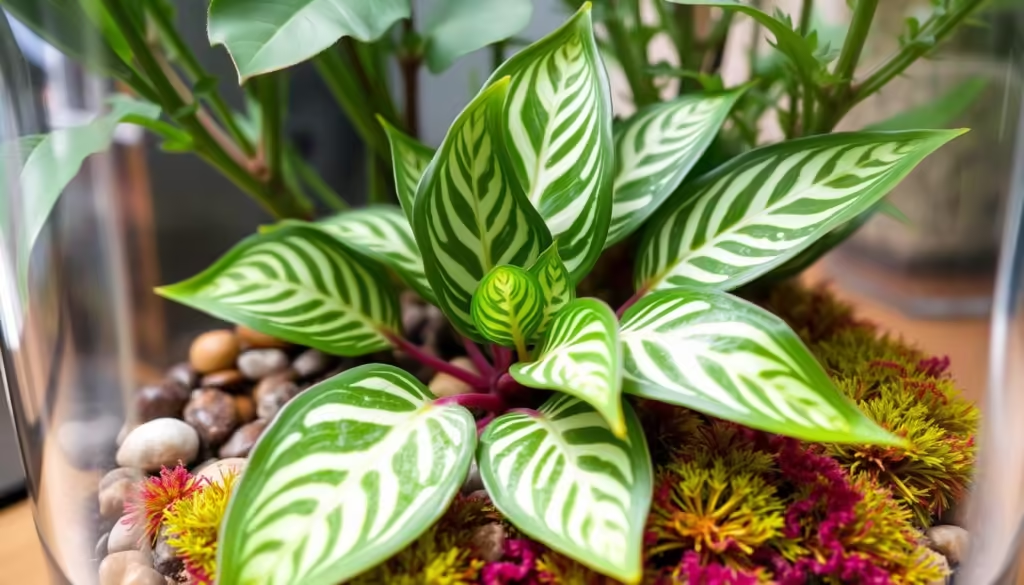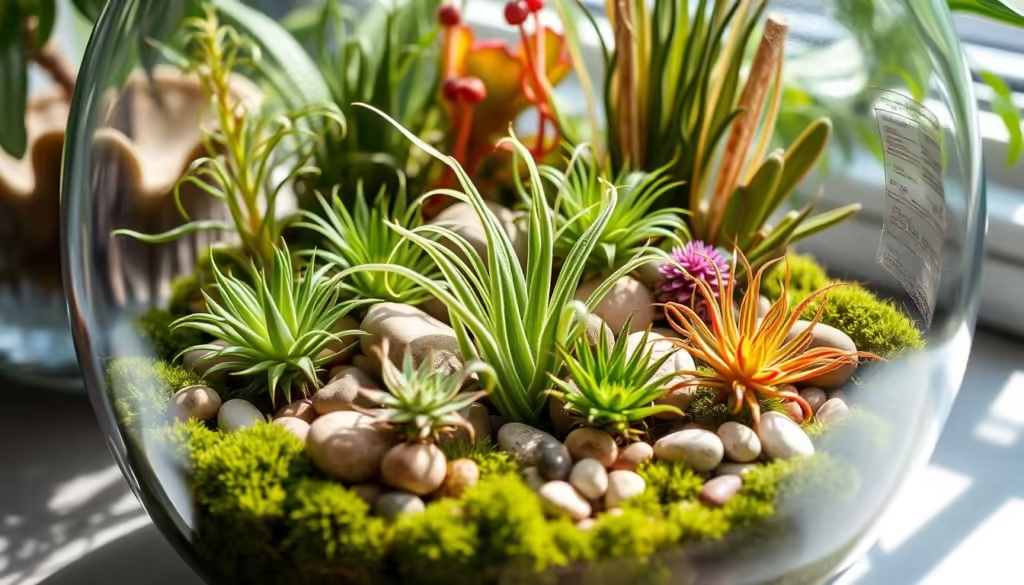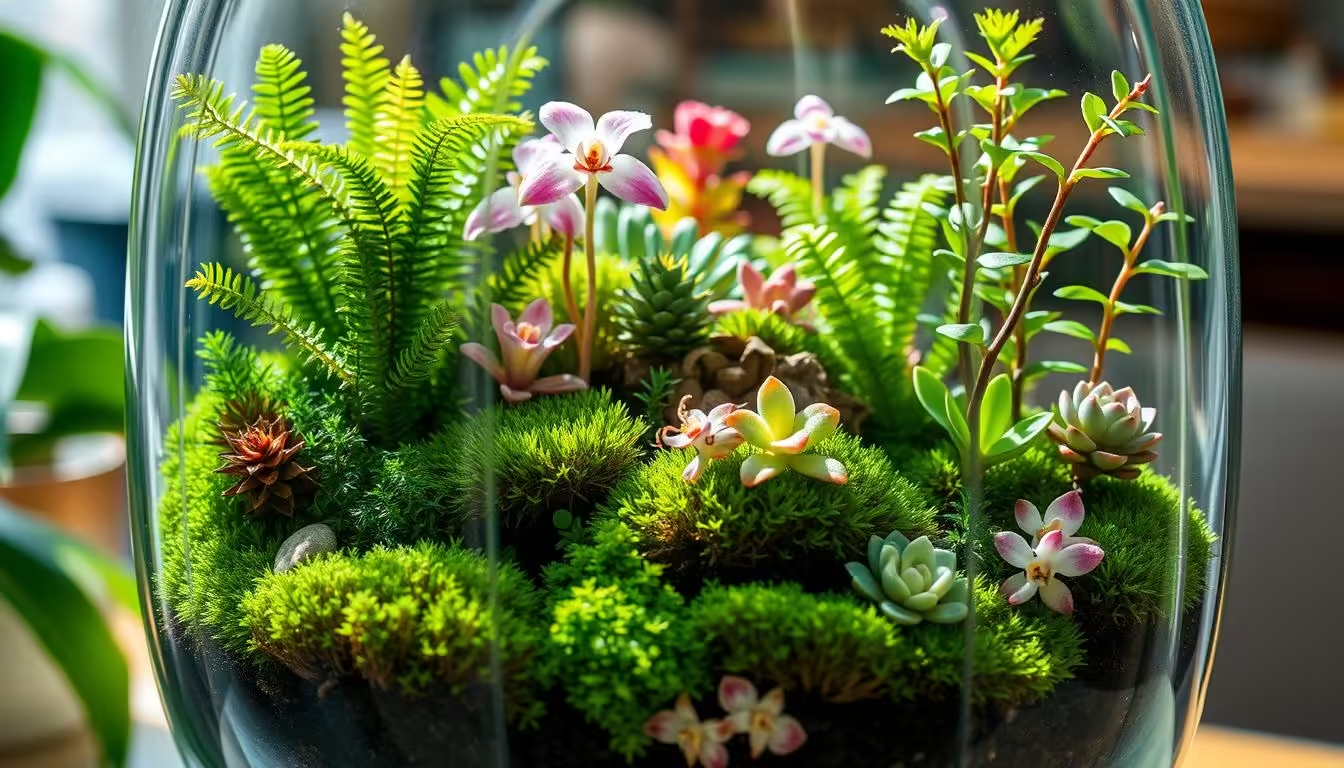Ever thought of having a lush garden in your living room, even with little space? Terrariums make it possible. They’re mini gardens that bring nature indoors with minimal care. In this article, we’ll dive into the best plants you can grow inside a terrarium.
Terrariums are great for city folks without outdoor space. They can be humid or dry, depending on your preference. The trick is picking the right plants for your terrarium.
Key Takeaways
- Terrariums are perfect for creating a garden-like space indoors, ideal for urban living.
- Various plant types can thrive in either closed or open terrariums.
- Closed terrariums suit humidity-loving plants, while open ones are better for dry, arid conditions.
- Low-maintenance and compact plants are most suitable inside a terrarium environments.
- Choosing the right plants can turn your terrarium into a stunning focal point in your home.
- Understanding the care requirements of each plant type ensures a thriving terrarium.
Introduction to Terrarium Plants
Terrariums have a long history, starting in the Victorian era of the 1850s. They are mini-greenhouses where plants can grow with little care. The key to a thriving terrarium is picking the right plants. By choosing the right indoor terrarium plants, we can create a beautiful, easy-to-care-for mini garden.
There are two main types of terrariums: open and closed. Each needs specific plants inside a terrarium to do well. Closed terrariums are great for plants that love high humidity, like ferns and African violets. These plants can go months without needing water, as most of it is reused in the ecosystem.
Open terrariums are better for plants that like lower humidity, such as succulents. It’s important to pick the right small terrarium plants for your terrarium. They should like the same soil moisture and light to grow well together.
To make a terrarium, you need a container, drainage like LECA or gravel, and a good soil mix. Activated charcoal helps filter out toxins. Plants are the heart of the terrarium. Fertilizer is usually avoided to stop plants from growing too fast. Regular pruning helps keep plants in check.
- Net plants, moss, ferns, and African violets are ideal for closed terrariums.
- Succulents and cacti thrive in open terrariums.
- Terrariums without drainage may need watering every 3 to 6 months.
- Medium to bright, indirect sunlight keeps plants healthy without overheating.
Knowing what indoor terrarium plants need helps keep our mini gardens lively and lovely for months. Terrarium gardening is a fun and beautiful hobby.
Choosing the Best Closed Terrarium Plants
A closed terrarium is a great place for plants that love humidity. It’s important to pick plants that do well in a small, wet space.
Nerve Plant (Fittonia)

(Fittonia) is a top pick for terrariums. It has colorful leaves and grows well in small spaces. This makes it perfect for adding color and texture to your mini garden.
Asparagus Fern
The asparagus fern has soft, feathery leaves that look great in a terrarium. It’s a bit toxic but loves the moist terrarium air. Its delicate fronds add elegance, even in low light.
Moss Varieties
There are many moss for terrarium types, like cushion moss and sheet moss. They create a lush, green carpet. Mosses are easy to care for and keep the soil in place, making your terrarium look beautiful.
Choosing the right plants to grow inside enclosed terrariums makes your space green and lively. Plants like the nerve plant, asparagus fern, and mosses make your terrarium vibrant and balanced.
Top Plants for Open Terrariums
Choosing the right plants is key for open terrariums. These plants love drier air and need less care for humidity. Let’s explore some great options.
Air Plants (Tillandsia)
Air plants (Tillandsia) love the dry air of open terrariums. They don’t need soil, getting moisture from the air. They’re easy to care for, making them great for beginners. Just make sure they get some air and a bit of mist now and then.

Cacti and Succulents
Cacti and succulents are perfect for open terrariums because they like dry air. They add color and texture, with plants like Echeveria, Sedum morganianum ‘Burrito,’ and Crassula ovata ‘Minima’ being top picks. Cacti like Mammillaria rhodantha and Opuntia rufida ‘Minima’ also add beauty. Just remember, good drainage is crucial to avoid root rot.
Haworthia
Haworthia, a succulent, is also great for open terrariums. It has a beautiful rosette shape and does well in various light, but prefers indirect sun. It’s easy to care for: water when the soil is dry and don’t get the leaves wet. This makes it a favorite among many.
Using these plants in your open terrarium will create a beautiful mini-garden. Whether you choose air plants, succulents, or Haworthia, your terrarium will thrive with little effort.
Why Low Maintenance Plants Are Ideal Inside A Terrarium
Recently, terrariums have become more popular. This shows people want to add plants to their homes. Low maintenance plants are perfect for terrariums because they need little care. This makes it easy to keep your terrarium looking great, even when you’re busy.
For those without a big garden, terrariums are a great option. They keep plants healthy by controlling humidity, light, and temperature. These plants don’t need a lot of care, making them perfect for anyone.
Closed terrariums are almost self-sustaining. They need only occasional watering and pruning. They’re great for plants that love moisture, like mosses and ferns. Open terrariums, however, are better for plants that like dry air and lots of light, like cacti and succulents. They also get better air flow, which helps prevent mold.
Here’s a detailed comparison of the advantages of low maintenance plants in terrariums:
| Advantages | Closed Terrariums | Open Terrariums |
|---|---|---|
| Watering Frequency | Minimal, few times a year | Occasionally, depending on plant needs |
| Humidity Control | High, self-regulating | Medium to low, depending on room conditions |
| Plant Types | Mosses, ferns, orchids | Cacti, succulents, air plants |
| Maintenance | Minimal pruning and watering | Reduced risk of mold and easier access for care |
| Environmental Impact | Very low, less water and soil needed | Low, suitable for water-efficient plants |
Using low maintenance plants in your terrarium means you can have a beautiful space without worrying about it. With the right care, both easy and low maintenance plants can thrive. This makes your home look great and feel relaxing.
The Importance of Proper Lighting in Terrariums
Welcome to our deep dive into terrarium lighting, a key part of terrarium plant care. The right lighting is crucial for your plants’ growth and health. Whether your terrarium is closed or open, knowing what your plants need is essential.

In closed terrariums, indirect sunlight for terrariums is best. These plants love warmth but not direct rays that can overheat them. Place your terrarium in a spot with bright, indirect light. This helps plants like Fittonia and moss varieties photosynthesize well. Direct sunlight can trap too much heat, harming the plants inside.
“Lighting is like the lifeline for your terrarium! Get it right, and watch your mini jungle flourish!”
Open terrariums, on the other hand, can handle more direct light. Plants like cacti and succulents do well in brighter conditions. But, too much direct light can dry out and burn the leaves. A spot near a window with diffused sunlight is best for these plants.
When using artificial light, the bulb type matters a lot:
- Incandescent bulbs: Give intense but short light, great for showing off your terrarium.
- Fluorescent bulbs: They’re energy-efficient and last long, perfect for terrarium care with little energy use.
- LED lighting: Offers bright, white light with low energy use, but watch out for heat.
Natural light is the best for consistency and efficiency. But, it’s limited by day and weather. So, mixing natural and artificial light often works best.
Here’s a quick look at different lighting options:
| Lighting Type | Pros | Cons |
|---|---|---|
| Incandescent | Intense light, looks good | Creates heat, doesn’t last long |
| Fluorescent | Uses less energy, lasts longer | Moderate heat, light isn’t as intense |
| LED | Light is bright, uses less energy | Can get hot, more expensive at first |
Managing terrarium lighting well means your plants can grow with little care. Think about your terrarium type and plant needs to choose the best light. Let’s keep our mini worlds healthy!
Plants Inside a Terrarium: Creating a Mini Jungle
Creating a terrarium is like designing a miniature rainforest in your home. With the right terrarium setup, we can create an indoor jungle. This brings greenery to our space and teaches us about ecosystems.
A terrarium has four main layers like a rainforest: forest floor, understory, canopy, and emergent. We can use foliage, ferns, and vines to get that jungle look. For the forest floor, pleurocarpous and acrocarpous mosses
Foliage plants like the Asparagus Fern and Polka-dot Plant are perfect for the understory. They look good and are easy to care for. For the canopy and emergent layers, mix Pilea varieties with small vines. This adds vertical interest and lush greenery.
Layering the terrarium setup correctly is key. Start with gravel for drainage, then dried moss and horticultural charcoal. Use a mix of peat-free compost and perlite for the planting layer. This mix helps the roots grow, keeping the mini jungle healthy.
One great thing about terrariums is they need little water. Once set up, they only need watering every few months. A 53-year-old terrarium has only been watered once! This shows how self-sustaining terrariums can be, making them a great choice for plant care.
Building your mini indoor jungle is quick and affordable. Most setups take less than 20 minutes and cost under $20! You can find materials at local nurseries, big box stores, or thrift stores. Creating a terrarium is rewarding and educational.
Here’s a simple guide to organizing your terrarium:
- Start with a layer of gravel.
- Add dried moss and horticultural charcoal.
- Top with peat-free compost mixed with perlite.
- Select and arrange foliage, ferns, and vines.
- Introduce moss types and microfauna for ecosystem balance.
Through creating a terrarium, we nurture a small, vibrant ecosystem. This not only beautifies our space but also deepens our appreciation for nature’s balance.
Combining Different Plant Types for Aesthetic Appeal
The art of making beautiful terrariums is about mixing different plants. Each plant adds its own colors, textures, and growth patterns. By choosing the right plants, we can make any terrarium lively and eye-catching.
One great idea is to mix plants like ferns, mosses, and succulents. Ferns give a lush green look with their feathery leaves. Mosses, like Carpet Moss or Cushion Moss, love high humidity and look great as ground cover. Succulents add interesting shapes and colors, making a beautiful contrast with ferns and mosses.
Creating themed terrariums is also a great idea. For example, a rainforest theme could have Boston Ferns and Nerve Plants. A desert theme might include cacti and succulents like Haworthia. This lets us express our creativity and make our terrariums personal.
It’s important to group plants by their water and humidity needs. This helps all plants do well in our mini-ecosystem. Closed terrariums are good for plants that love high humidity, like Fittonia and Asparagus Ferns. Open terrariums are better for cacti and succulents, as they need sunlight and air.
By trying out different terrarium plant ideas, we can make beautiful, easy-to-care-for terrariums. These not only look great but also improve our well-being.
How to Care for Your Terrarium Plants
Keeping your terrarium plants healthy is key. We’ll talk about watering, managing humidity, and solving common problems. This will help you take good care of your terrarium.
Watering Techniques
Watering terrarium plants is more than just pouring water in. For closed terrariums, avoid too much water. Mist lightly or use targeted watering instead. Too much water can cause mold and algae.
Water your terrarium only a couple of times a year. But, check your plants every day to prevent them from drying out.
Managing Humidity Levels
Keeping the right humidity is crucial. Tropical plants need about 80% humidity. Closed terrariums love this moist environment, but watch out for mold.
Open your terrarium regularly or add springtails and chamomile tea to control mold. Also, keep the temperature between 15-24°C. Avoid temperatures above 30°C or below 10°C, as they can harm your plants.
Avoiding and Treating Common Issues
Spotting and fixing common problems quickly is important. Issues like fungus gnats and mold can happen if humidity control fails. Use nematodes for fungus gnats and chamomile tea for mold.
Also, remove dead leaves, manage plant growth, and ensure they get enough light. Watch for signs like wilting, brown leaves, and low condensation. These signs can help prevent bigger problems.
| Aspect | Recommendation |
|---|---|
| Watering Frequency | Water only a couple of times a year, with daily observations. |
| Ideal Humidity | Around 80% for tropical plants. |
| Temperature Range | 15-24°C (59-75°F) |
| Light Conditions | Bright but indirect light, at least 200 footcandles. |
| Common Issues | Fungus gnats, mold, and plant overgrowth. |
| Maintenance Tips | Regular cleaning, removing dead leaves, and controlling mold. |
Conclusion
Creating a terrarium is a rewarding experience. It brings life to your space and supports sustainable living. Terrariums are now popular for adding greenery to homes.
Choosing the right plants to grow inside this small space and following care tips makes terrarium growing easy. Closed terrariums are great for tropical plants like ferns. Open terrariums are best for succulents and cacti. Good lighting is key for healthy plants.
Terrariums are more than just decorations. They offer a creative outlet and stress relief. They’re perfect for small spaces and are easy to care for. This hobby connects you with nature’s beauty.
FAQ
What are the best plants for a terrarium?
How do I choose the right plants for a closed terrarium?
Can you recommend plants for an open terrarium?
What does terrarium plant care involve?
Are there any plants that are easier to maintain in a terrarium?
How important is lighting for terrarium plants?
How can I create an aesthetically pleasing terrarium?
What are the best watering techniques for terrarium plants?
How do I manage humidity levels in a closed terrarium?
What are common issues in terrariums and how can I treat them?
Want To Learn More, Check Out These Links:
- 25 best terrarium plants for beginners
- Terrarium plants – Blooming Lucky
- 25 Easy Terrarium Plants for Open or Closed Glass
- How to Create and Care for a Terrarium
- Closed Terrarium Plants That Thrive: Expert Recommendations
- The Best Terrarium Plants for Beginners (Expert Picks)
- How to Make an Open Terrarium (Best Plants + Fun Ideas) – Terrarium Tribe
- Create a Mini Ecosystem with These Terrarium Plants
- The Ultimate Guide to Open vs Closed Terrariums
- Terrarium Lighting: The Most Complete Guide
- Jungle Magic: How to Make a Captivating Rainforest Terrarium
- Make a mini jungle terrarium
- DIY: Making a Terrarium. — The Midwestern Jungle.
- The Complete Terrarium Care Guide (Avoid These 7 Mistakes)
- What is a Terrarium Plant? How to Judge Size & Suitability – Terrarium Tribe
- The Art & Care of Terrariums | Gardens of Babylon

